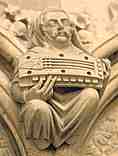
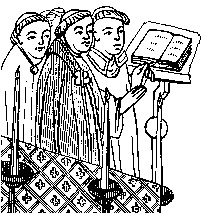



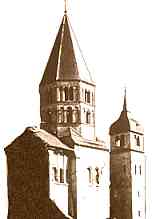
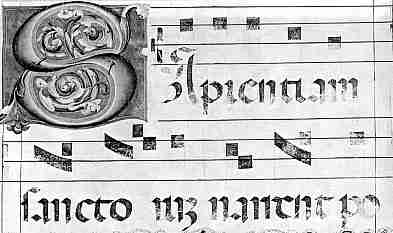
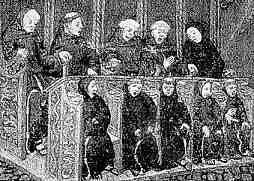
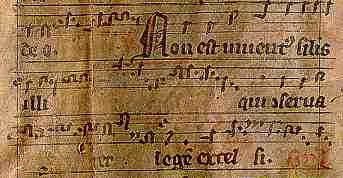
If you are looking at this page without frames, there is more information about medieval writing to be found by going to the home page (framed) or the site map (no frames).
| Music | ||||||
 |
The history of written music very much parallels the history of the written word. Music was around as an oral tradition much, much earlier than its recording in manuscript. As with the written word, the literate church pioneered the process of notating music for the purpose of recording the liturgy. In the earliest music manuscripts, this was in a very imprecise form, and served basically as a memory aid for the priest or choir master who had committed it all to memory. | |||||
| A hurdygurdy player is one of many musicians who adorn the nave arcading in Beverley Minster, East Yorkshire. | ||||||
 |
Early church music was monophonic. That is, the whole choir sang the same melody in the form known as plainchant, where the tune follows the rhythm of the words. It is also known as Gregorian chant on the basis that it was all devised by Pope Gregory the Great, but that, I think is up there with King Alfred translating the Bible and Charlemagne reforming the liturgy. I am sure Pope Gregory had a platoon of liturgical experts actually doing it for him and his successors. | |||||
| Singing the liturgy. | ||||||
 |
||||||
| Two lines with musical notation from a late 10th century pontifical, in a service for the consecration of a church (Paris, Bibliothèque Nationale, MS Latin 943, f.10). (From The New Palaeographical Society 1907) | ||||||
 |
||||||
| Musical notation in an 11th century Mozarabic antiphoner from Spain (British Library, add ms 30850, f.105v), by permission of the British Library. | ||||||
 |
||||||
| Musical notation from a 12th century missal executed for the Benedictine nunnery of St Peter, Benevento, Italy (British Library, Egerton 3511, f.173v), by permission of the British Library | ||||||
| The above examples are all from works of liturgy. The text of the pontifical is written in a very formal and rounded insular minuscule script. The antiphoner is in Visigothic minuscule, while that of the missal is Beneventan minuscule. The musical signs which represent how each syllable is to be sung are called neumes, and it can be seen that they come in various forms and are arrayed up and down to indicate the rise and fall of the music. There is a great deal of code here for the choirmaster, but there are no staves to indicate exact pitch, or time signatures, key signatures or other codes which we depend on to accurately render a piece of music. These are also small volumes, for the use of the choirmaster, or the priest or deacon performing the solo parts, not the whole choir, and it must be presumed that the choir learned their material off by heart. | ||||||
| To look at some pages of early neumes while listening to a wonderful choral ensemble singing the music on the pages, go to the beautiful website Musical Treasures from the Library of St Gall. Take some time to read the associated material, as there is a great story that goes from the age of Charlemagne to the age of digital reproduction of manuscripts. If you don't read German and Google translations leaves you confused and seasick, just click the play button under the main picture and follow the music. | ||||||
| Around the 11th century, liturgical music began to become more complex. The elaborate and extensive liturgy of Cluny was influential in this. Fancy elaborations known as tropes were added to some significant passages in the mass, and the trend towards polyphony began. There were various experiments in more precise forms of musical notation, but they tended to be complex and difficult to interpret. |
 |
|||||
| The fragmentary remains of the monastic church of Cluny. | ||||||
| An example of Aquitanian notation of the 11th century is displayed by Greta-Mary Hair on the website Our Medieval Heritage. To understand the complex process of decoding the notation, you will just have to get hold of a copy of the book. | ||||||
| A simplified, but more accurate, method of representing music is credited to one man, Guido d'Arezzo in the 11th century, although like most accreditations of this sort, it is not absolutely accurate as he had some experimental predecessors. This system was the basis for all later medieval musical notation, and placed the notes on a four line staff with clefs to indicate the pitch. As choirs became more dependant on musical literacy and less on prodigious feats of memory, very large format music books were produced, often with lavish production and decoration, for the use of the whole choir. The notes were rendered as very big and easily visible rectangles, so the system is referred to as square notation. | ||||||
 |
Square notation in a late 15th century Italian choral book (London. Library of the Society of Antiquaries). (From The New Palaeographical Society 1909) | |||||
| The Italian style of display script, something of a hybrid between Gothic rotunda and humanistic script, in the above example, is highly suitable for the purpose of providing a clear, legible script to be read from a distance. | ||||||
 |
Monks in choir, as depicted in a late medieval psalter and badly reproduced in a decrepit old school textbook. | |||||
| Columbia University displays images of an 11th century German manuscript with neumes on four line staves. The Wallace Library, Rochester Institute of Technology, has a leaf from an early 13th century English gradual as well as one from an early 15th century Italian antiphonal. Columbia University's Celebrating the Liturgy's Books has numerous illustrations of musical leaves. There are plenty of others out there if you look for them. An exceptional site is that of the State Library of south Australia, The Antiphonal, which shows a complete 13th century antiphoner. Exploring Medieval Music Manuscripts appears to be the enthusiastic investigation by an owner of pages from a gradual and an antiphonal into their technicalities, and is well worth an exploration. | ||||||
 |
A segment from a fragment of a 13th century German liturgical manuscript, from a private collection. | |||||
| While the introduction of square notation is claimed to be one of those revolutionary changes that suddenly altered everything, such generalisations are rarely strictly true. The example above, from the 13th century in Germany, employs what is called Hufnagelschrift, or horseshoe nail script, on the basis that the neumes, which have continued to be used, look like horseshoe nails. This notation employs a four line staff. The pitch of the lines can vary from staff to staff, as indicated by a c type symbol on the left hand side and a red line indicating either a line or space. If the c symbol represents the note C, then the red line must represent F, or perhaps it is simply a way of visually depicting the same note interval on each staff. This system uses the more complex and interpretive system of neumes overlaid on to the more precise system of a staff. And no, I'm afraid I don't know the significance of all those things that look like dots, commas, horseshoe nails and bits of string. | ||||||
| Musical notation could be found in the complete books of liturgy, the missal and the breviary, as well as in specialised books for the choir, such as the gradual, antiphoner, hymnal, troper or processional. In the later part of the middle ages, this musical literacy extended beyond the cloister into the world of secular music. | ||||||
| A concise but clear history of this process can be found in the Development of Musical Notation, part of the Liturgica.com website. C. Parrish 1978 The Notation of Medieval Music New York: Pendrago Press is a good basic textbook on the subject, but somewhat ancient in its original publication with rather grungy illustrations. N. Bell 2001 Music in Medieval Manuscripts University of Toronto Press is a more slender volume with yummy photographs. | ||||||
|
|
||||||
|
If you are looking at this page without frames, there is more information about medieval writing to be found by going to the home page (framed) or the site map (no frames). |
||||||